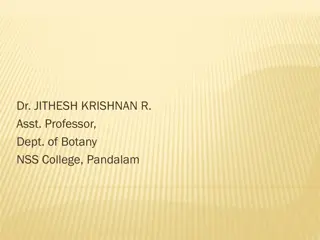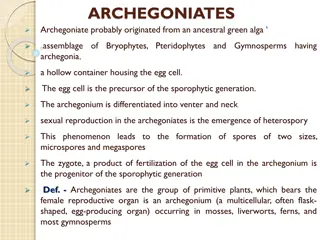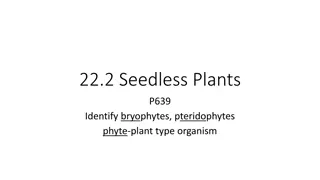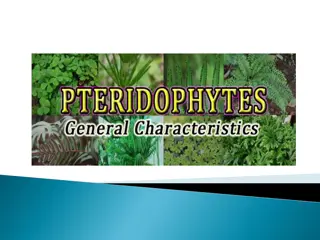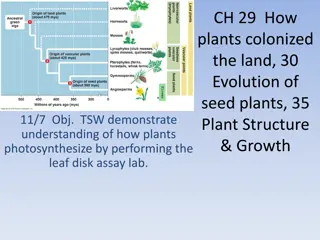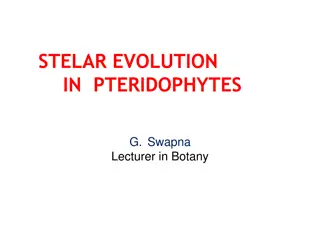Fossil Plants: Sphenophyllum and Zygopteris Anatomy
Dr. Jithesh Krishnan R, Asst. Prof. at NSS College, Pandalam, specializes in studying Fossil Pteridophytes like Sphenophyllum and Zygopteris. These ancient plants date back to the Devonian period and showcase unique stem anatomy resembling roots. Sphenophyllum had slender shoots with whorled leaves,
0 views • 11 slides
Archegoniates: Primitive Plants with Unique Reproductive Structures
Archegoniates are a group of primitive plants believed to have originated from ancestral green algae. They possess distinct reproductive structures such as archegonia, which house the egg cell and give rise to the sporophytic generation. Heterospory in archegoniates leads to the formation of microsp
0 views • 15 slides
Understanding Seedless Plants: Bryophytes and Pteridophytes
Explore the world of seedless plants through bryophytes and pteridophytes. Learn about the characteristics of green algae, the life cycles of these plants, and how vascular tissue impacts their growth. Discover the limitations and importance of vascular tissue in plants, from the small yet significa
0 views • 8 slides
Workshop on T.Y.B.Sc. Botany Revised Syllabus Semester VI at R.P. Gogate College of Arts & Science and R.V. Jogalekar College of Commerce
This workshop, held on 18th Feb 2019, introduced the revised syllabus for Semester VI of the T.Y.B.Sc. Botany program at R.P. Gogate College of Arts & Science and R.V. Jogalekar College of Commerce in Ratnagiri. The syllabus covers topics such as plant diversity, form and function, current trends in
0 views • 26 slides
General Characteristics and Reproduction in Pteridophytes
Majority of living Pteridophytes, including terrestrial, aquatic, xerophytic, and epiphytic species, exhibit unique characteristics in their plant body structure. They possess sporophytic plant bodies with differentiated root, stem, and leaves, showcasing a variety of forms and adaptations. Reproduc
0 views • 21 slides
Evolution of Land Plants: Colonization and Adaptations
Land plants evolved from Charophyceans, the closest algal relative, adapting to life on land through characteristics like multicellularity, photosynthesis, and specialized reproductive cycles. They diversified into four main groups: Bryophytes, Pteridophytes, Gymnosperms, and Angiosperms, each with
0 views • 12 slides
Plant Kingdom Diversity and Characteristics
Explore the intriguing world of the plant kingdom through topics like classification by notable scientists, gamete characteristics in Phaeophyceae, unique features of Bryophytes, and the significance of Bryophytes as the amphibians of the plant kingdom. Delve into the structures and functions of pla
0 views • 21 slides
Understanding Plant Evolution and Characteristics
Plants colonized land through various adaptations such as multicellularity and photosynthesis. They exhibit characteristics like chlorophyll, cellulose cell walls, and apical meristems. Plant evolution includes alternation of generations, with gametophytes and sporophytes undergoing meiosis and mito
0 views • 15 slides
Evolution of Steles in Pteridophytes: An Overview
This detailed presentation explores the evolution of steles in pteridophytes, discussing basic types such as protostele and siphonostele, and specific variations like haplostele, actinostele, and solenostele. The origin of siphonostele and the evolutionary progression of vascular tissues are also el
0 views • 10 slides
